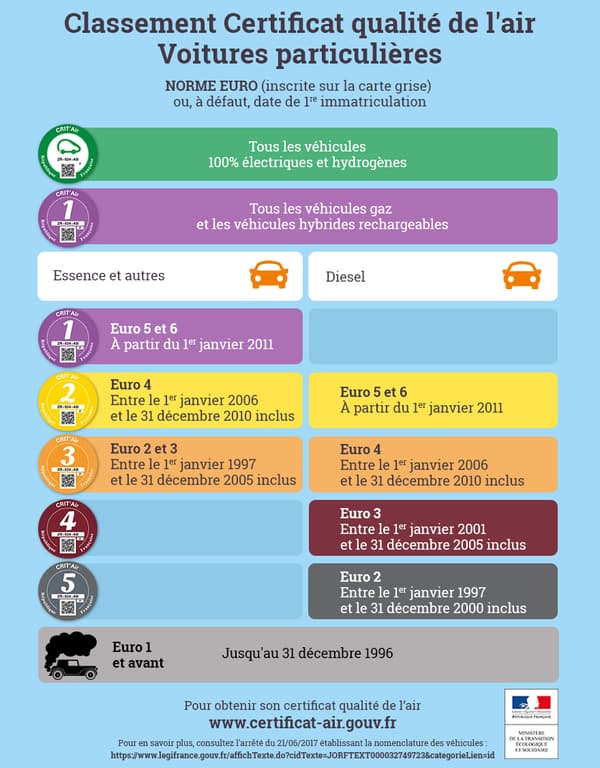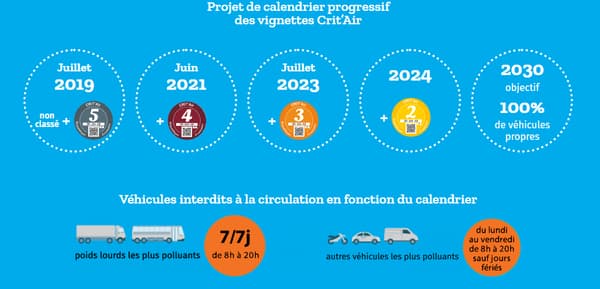An “educational” traffic ban that risks becoming a photovoltaic machine gun in the coming months: this is what some motorists fear in the face of the generalization of EPZs. These “Low Emissions Zones” make it possible to restrict the circulation of certain vehicles, considered the most polluting, according to their Crit’Air sticker. A vignette to buy once per vehicle for 3.70 euros on the official website of the Ministry of Ecology (beware of the many fraudulent websites).
However, at the moment, no sanctions are applied to people in areas where such a system exists, even for several years, such as Greater Paris, Greater Lyon or Grenoble… but since when? By 2025, all agglomerations with more than 150,000 inhabitants must have published at least one schedule of planned closures. The first verbalizations are expected by the end of the year or the beginning of 2023, in particular with the number plate reading radars.
A situation that the association of 40 million motorists describes as a “social time bomb” in a press release released on Monday, September 26. “We are in the process of organizing a scheduled obsolescence date on the car,” Fabrice Godefroy, mobility and environment expert within 40 Million Motorists, summarizes this Tuesday on BFMTV. The association is considering various actions against this regulation.
• What recourse against EPZs?
In particular, the association of 40 million motorists has chosen to support a bill presented by the Rassemblement National deputy for the 2nd district of Marne, Anne-Sophie Frigout, which aims simply to “eliminate the principle of Zones to Low Emissions”. .
“In the explanatory memorandum worked out in collaboration with the association, the deputy insists on the impossibility today of prohibiting the circulation of almost half of the French,” continues the press release.
Main argument: “the incomprehension of millions of French people who properly maintain their cars, successfully overcome the mandatory anti-pollution technical control but who are prohibited from accessing metropolises with more than 150,000 inhabitants.”
The association also announces that it supports the appeal before the Administrative Court of one of its members who attacks the Crit’Air sticker and its vehicle classification system in force since 2015 and on which the ZFE calendar is based.

A classification considered not suitable for determining the level of contamination of a vehicle, taking into account only an argument of age. The vehicle of this member of 40 million motorists, “classified Crit’Air 2, effectively meets the polluting emission obligations imposed by the euro standard, giving the right to the Crit’Air 1 sticker”, explains the association, whose lawyers will support this action.
Finally, trips are planned throughout France to raise awareness on this issue, in Reims on October 7, Rouen on October 21, Montpellier on November 4 and Lyon, Grenoble and Saint-Etienne on November 18 and 19.
• Which agglomerations are affected by EPZs?
France already has a dozen EPZs, as a result of the mobility orientation law (or LOM) approved at the end of 2019. Some were created several years ago, such as Grenoble-Alpes Métropole, Métropole du Grand-Paris, or Greater Metropole of Lyon. And other more recent ones, such as the Métropole d’Aix-Marseille-Provence or Toulouse Métropole.
The Law of Climate and Resiliencevoted in 2021, clearly generalized the principle of the ZFE: before December 31, 2024, all agglomerations of more than 150,000 inhabitants should have implemented what now bears the official name of “ZFE-m”, for “Zones of low mobility emissions.
If there is no calendar available in your area, you should still expect a ban targeting at least Crit’Air 5 in 2023, Crit’Air 4 in 2024 and Crit’Air 3 in 2025, which corresponds to the trajectory provided by the Law. of the weather.
It should be noted that the ZFEs also enable specific aid for the change of vehicles. Subsidies that can be combined with the devices established at the national level, such as the ecological bonus and the conversion bonus.
• What vehicles are prohibited from circulating?
If we focus on individuals and take the example of the most “advanced” metropolis currently in its calendar, that of Greater Paris, here is the current table:
Non-classified private vehicles (registered before 1997), Crit’Air 5 (diesel before 2001) and Crit’Air 4 (diesel before 2006) are prohibited from driving in the area delimited by the A86 (not included) on weekdays from 8 a.m. to 8 p.m. in the afternoon (for buses, coaches and heavy goods vehicles, the ban also applies on weekends). We are still talking about a “permanent” traffic ban, as opposed to specific bans, decided during pollution peaks, with the differentiated traffic system (according to the number of the Crit’air label, which replaced the alternate traffic system, according to even or odd license plate).
Important next steps for the Greater Paris metropolis: the ban on Cit’Air 3 (petrol before 2006 and Diesel before 2011), postponed to July 2023 and, above all, that of Crit’Air 2 which will mean driving ban for all diesel vehicles, even the most recent ones, as well as gasoline models (including hybrids) before 2011) scheduled for 2024. That’s tomorrow on the scale of vehicle ownership.

In other metropolises, such as Lyon, it should be noted that the driving ban is “really” permanent and therefore not limited to weekdays from 8 a.m. to 8 p.m. as in Paris. The agglomeration has also just implemented the first phase of its system aimed at individuals, so far they have only been aimed at professionals. Since September 1, an “educational” ban has been applied to vehicles bearing the Crit’Air 5 label and unclassified vehicles. Elected officials are also due to vote this week to extend the ZFE to new municipalities. The vehicles will be sanctioned from January 1, 2023, foresees the metropolis of Greater Lyon (see below “what sanctions?”)
Another example in Toulouse, where until now only vans, vans and HGVs are affected by traffic restrictions in the agglomeration, but which is preparing to suddenly ban on January 1, 2023 private vehicles carrying Cirt’ vignettes Air 4, 5 and unclassified.
To understand the number of vehicles potentially affected, the interactive table below shows the workforce by region (by default, data is presented at the national level) with details by Crit’Air label (AAA data as of October 2021).
• What sanctions?
This is the whole problem today: some schedules are already implemented… but without verbalization and without real awareness of the general public in a context of imminent “real” implementation.
In Paris, the implementation of video verbalization, presented as a prerequisite for law enforcement, is constantly being postponed. It would allow violators to be sanctioned directly thanks to their license plate, which is equivalent to a Crit’Air sticker.
Officially, there is a third class fine for private vehicles circulating with an unauthorized sticker, that is, a fixed fine of 68 euros. “The planned offenses may lead to the immobilization of the vehicle”, specifies the site of the city of Paris.
In Lyon, after the 4-month educational phase, the first sanctions for Crit’Air 4, 5 and unclassified are scheduled for January 1, 2023. “Environmentalists have announced the deployment of about sixty radars to enforce their device”, specifies an article by Lyon Capitale published this Monday, September 26.
You can also be fined 68 euros if you do not have the Crit’Air sticker on your windscreen during an inspection or if the sticker does not match your vehicle.
• What exemptions?
There are, however, many exceptions. In the first place at the national level, with “priority general interest vehicles” (police, gendarmerie, customs, firefighters, ambulances, transport of detainees…), “general interest vehicles with ease of passage” (for electricity and management companies of gas infrastructures, SNCF, transport of Banque de France funds, transport of blood products and human organs), but also vehicles of the Ministry of Defense, vehicles for the disabled (including the mobility card) or public transport buses.
But there are also so-called “local” exemptions, remember the metropolis of Greater Paris: collection vehicles, market supply vehicles, professional movers, tanker or refrigerated vehicles, those authorized for filming.
In other cities, such as Toulouse, the exceptions can also apply to vehicles of solidarity companies, charities or even food producers that supply markets and shops.
There is no need to take any action, at least while the video verbalization is not in force: all you need is proof according to your category affected by an exemption, which you must present in the event of an inspection.
Source: BFM TV

